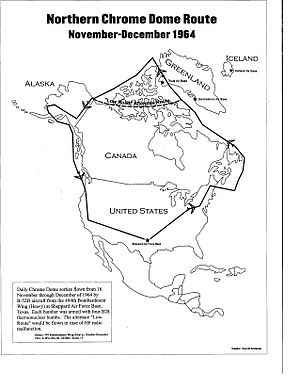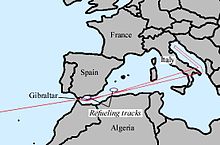- Operation Chrome Dome
-
Operation Chrome Dome was one of several United States Air Force Cold-War era airborne global alert duties or programs in which B-52 Stratofortress strategic bomber aircraft armed with thermonuclear weapons were assigned targets in the Soviet Union on schedules guaranteeing that a substantial number of them were flying and fueled for their missions at any given time.
Contents
Background
During the Cold War, B-52s performed airborne alert duty under code names such as Head Start, Chrome Dome, Hard Head, Round Robin[1], and Operation Giant Lance. Bombers loitered near points outside the Soviet Union to provide rapid first strike or retaliation capability in case of nuclear war.[2] [3]
Primary mission
A B-52D would leave Sheppard Air Force Base, Texas and fly across the United States to New England and head out to the Atlantic Ocean. The B-52 would refuel over the Atlantic heading north to and around Newfoundland. The bomber would change course and fly northwesterly over Baffin Bay towards Thule Air Base, Greenland. At this point it would fly west across Queen Elizabeth Islands of Canada. Continuing to Alaska, it would refuel over the Pacific Ocean again heading south-east and return to Sheppard AFB.[4]
Military units
The following military units were involved:
- Strategic Air Command Divisions:
- 306th Flying Training Group
- Homestead Joint Air Reserve Base
- Strategic Air Command in the United Kingdom
Accidents
The program was involved in the following nuclear-weapons accidents:
- 1961 Yuba City B-52 crash
- 1964 Savage Mountain B-52 crash[Notes 1]
- 1966 Palomares B-52 crash
- 1968 Thule Air Base B-52 crash
The Thule accident signaled the end of the program on January 22, 1968.
Notes
- ^ Accident happened while the aircraft was returning to its home base, having already completed its alert mission.
References
External links
- SAC'S Deadly Daily Dozen at Time Magazine
Categories:
Wikimedia Foundation. 2010.



